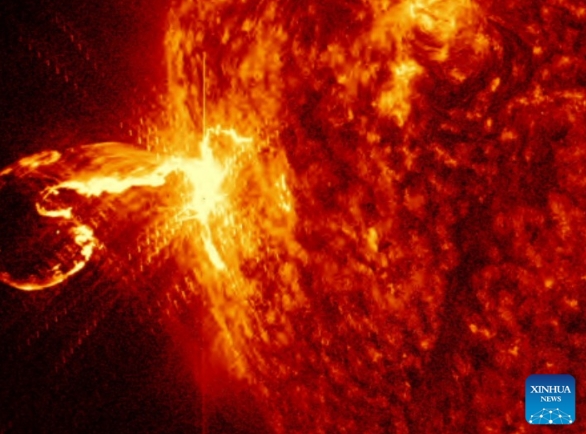China's space weather center predicts strong solar flares

This image provided by Beijing Normal University shows a solar flare with a coronal mass ejection. (Beijing Normal University/Handout via Xinhua)
China's National Center for Space Weather has predicted that there will be moderate to high levels of solar activity this week, with the possibility of more powerful solar flares.
Among the most intense phenomena from the sun, solar flares are characterized by sudden bursts of brightness in specific areas of the sun's atmosphere. They are often accompanied by an increase in electromagnetic radiation and the release of particles across various energy ranges. Solar flares are rated based on their strength, with A-class as the smallest, followed by B, C, M and X as the most potent.
According to the center, the sun unleashed a strong solar flare, classified as an X4.5, at 2:35 p.m. (Beijing Time) on Monday. Scientists at the space weather center issued a forecast on Tuesday, predicting that there is a possibility of M-class and X-class solar flares occurring in the next three days.
The sun's tantrums also follow a predictable cycle. According to Wang Jingsong, head of the center, the average duration of a Solar Cycle is 11.2 years. The first Solar Cycle commenced in 1755. Currently, the sun is in its 25th Solar Cycle.
The beginning of 2024 saw increased solar activities, with varying degrees of flares erupting in January and February.
Chen Anqin, chief forecaster of the center, said the number of X-class flares per Solar Cycle is approximately 100, and during the peak years, they would occur more frequently at a rate of about 10 to 20 per year.
Since the sun has reached the peak of the Solar Cycle, it is common to experience frequent X-class strong solar flares, Chen added.
The solar flares may affect people's lives on Earth. When solar flares occur, they can cause disruptions in the Earth's ionosphere due to their interaction with the sun. These disruptions have the potential to impact navigation and positioning systems, aviation communications, short-wave communications, as well as other emergency communication networks. They may also pose risks to satellites and in-orbit astronauts.
However, scientists said the impact of the solar flares on Earth would be minimal.
"While these flares can carry a significant amount of electromagnetic radiation and high-energy particles, only a small portion actually reaches the Earth. Moreover, our planet is protected by its own magnetic field, which means that even strong flares have little impact on human health," Chen explained, noting that there is no need for the public to worry or take any particular precautions.
Scientists believe that the occurrence of space weather events, such as solar flares and geomagnetic storms, is expected to increase in 2024 and the following year.
In the face of space weather events caused by strong solar activities, China has established a comprehensive system that integrates monitoring, forecasting and providing pertinent services. According to Wang, the system boasts a monitoring capability to accurately predict and provide early warnings for significant space weather phenomena such as geomagnetic storms.
The Chinese space weather center also provides round-the-clock space weather advisory services for global aviation.
Editor:伏娅敏
